Chenlong Zhang
Dual-View Disentangled Multi-Intent Learning for Enhanced Collaborative Filtering
Jun 13, 2025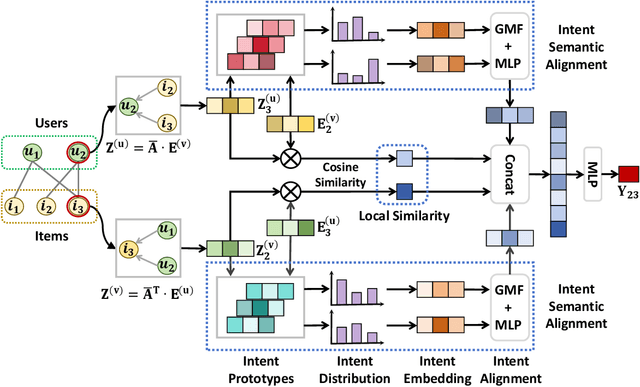

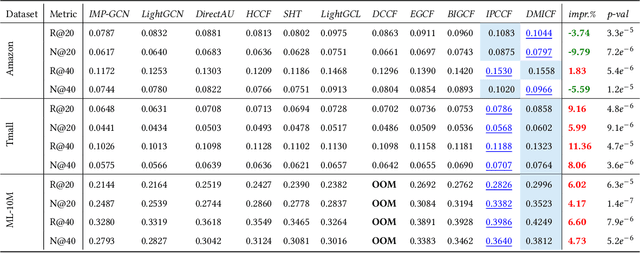

Abstract:Disentangling user intentions from implicit feedback has become a promising strategy to enhance recommendation accuracy and interpretability. Prior methods often model intentions independently and lack explicit supervision, thus failing to capture the joint semantics that drive user-item interactions. To address these limitations, we propose DMICF, a unified framework that explicitly models interaction-level intent alignment while leveraging structural signals from both user and item perspectives. DMICF adopts a dual-view architecture that jointly encodes user-item interaction graphs from both sides, enabling bidirectional information fusion. This design enhances robustness under data sparsity by allowing the structural redundancy of one view to compensate for the limitations of the other. To model fine-grained user-item compatibility, DMICF introduces an intent interaction encoder that performs sub-intent alignment within each view, uncovering shared semantic structures that underlie user decisions. This localized alignment enables adaptive refinement of intent embeddings based on interaction context, thus improving the model's generalization and expressiveness, particularly in long-tail scenarios. Furthermore, DMICF integrates an intent-aware scoring mechanism that aggregates compatibility signals from matched intent pairs across user and item subspaces, enabling personalized prediction grounded in semantic congruence rather than entangled representations. To facilitate semantic disentanglement, we design a discriminative training signal via multi-negative sampling and softmax normalization, which pulls together semantically aligned intent pairs while pushing apart irrelevant or noisy ones. Extensive experiments demonstrate that DMICF consistently delivers robust performance across datasets with diverse interaction distributions.
RULE: Reinforcement UnLEarning Achieves Forget-Retain Pareto Optimality
Jun 08, 2025Abstract:The widespread deployment of Large Language Models (LLMs) trained on massive, uncurated corpora has raised growing concerns about the inclusion of sensitive, copyrighted, or illegal content. This has led to increasing interest in LLM unlearning: the task of selectively removing specific information from a model without retraining from scratch or degrading overall utility. However, existing methods often rely on large-scale forget and retain datasets, and suffer from unnatural responses, poor generalization, or catastrophic utility loss. In this work, we propose Reinforcement UnLearning (RULE), an efficient framework that formulates unlearning as a refusal boundary optimization problem. RULE is trained with a small portion of the forget set and synthesized boundary queries, using a verifiable reward function that encourages safe refusal on forget--related queries while preserving helpful responses on permissible inputs. We provide both theoretical and empirical evidence demonstrating the effectiveness of RULE in achieving targeted unlearning without compromising model utility. Experimental results show that, with only $12%$ forget set and $8%$ synthesized boundary data, RULE outperforms existing baselines by up to $17.5%$ forget quality and $16.3%$ naturalness response while maintaining general utility, achieving forget--retain Pareto optimality. Remarkably, we further observe that RULE improves the naturalness of model outputs, enhances training efficiency, and exhibits strong generalization ability, generalizing refusal behavior to semantically related but unseen queries.
DTELS: Towards Dynamic Granularity of Timeline Summarization
Nov 14, 2024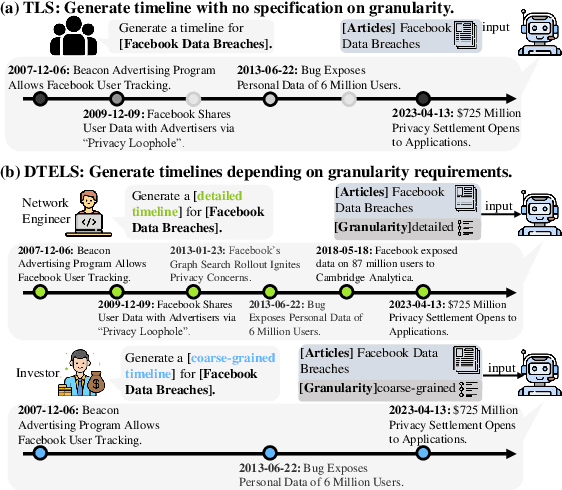
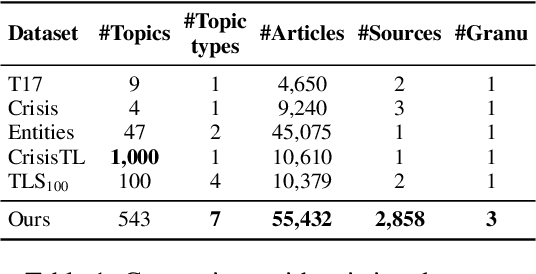
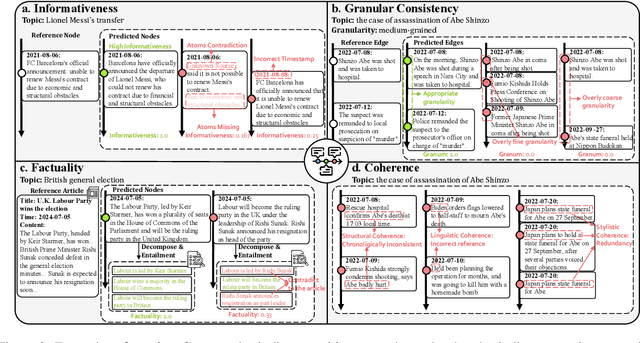

Abstract:The rapid proliferation of online news has posed significant challenges in tracking the continuous development of news topics. Traditional timeline summarization constructs a chronological summary of the events but often lacks the flexibility to meet the diverse granularity needs. To overcome this limitation, we introduce a new paradigm, Dynamic-granularity TimELine Summarization, (DTELS), which aims to construct adaptive timelines based on user instructions or requirements. This paper establishes a comprehensive benchmark for DTLES that includes: (1) an evaluation framework grounded in journalistic standards to assess the timeline quality across four dimensions: Informativeness, Granular Consistency, Factuality, and Coherence; (2) a large-scale, multi-source dataset with multiple granularity timeline annotations based on a consensus process to facilitate authority; (3) extensive experiments and analysis with two proposed solutions based on Large Language Models (LLMs) and existing state-of-the-art TLS methods. The experimental results demonstrate the effectiveness of LLM-based solutions. However, even the most advanced LLMs struggle to consistently generate timelines that are both informative and granularly consistent, highlighting the challenges of the DTELS task.
Continual Few-shot Event Detection via Hierarchical Augmentation Networks
Mar 26, 2024Abstract:Traditional continual event detection relies on abundant labeled data for training, which is often impractical to obtain in real-world applications. In this paper, we introduce continual few-shot event detection (CFED), a more commonly encountered scenario when a substantial number of labeled samples are not accessible. The CFED task is challenging as it involves memorizing previous event types and learning new event types with few-shot samples. To mitigate these challenges, we propose a memory-based framework: Hierarchical Augmentation Networks (HANet). To memorize previous event types with limited memory, we incorporate prototypical augmentation into the memory set. For the issue of learning new event types in few-shot scenarios, we propose a contrastive augmentation module for token representations. Despite comparing with previous state-of-the-art methods, we also conduct comparisons with ChatGPT. Experiment results demonstrate that our method significantly outperforms all of these methods in multiple continual few-shot event detection tasks.
 Add to Chrome
Add to Chrome Add to Firefox
Add to Firefox Add to Edge
Add to Edge